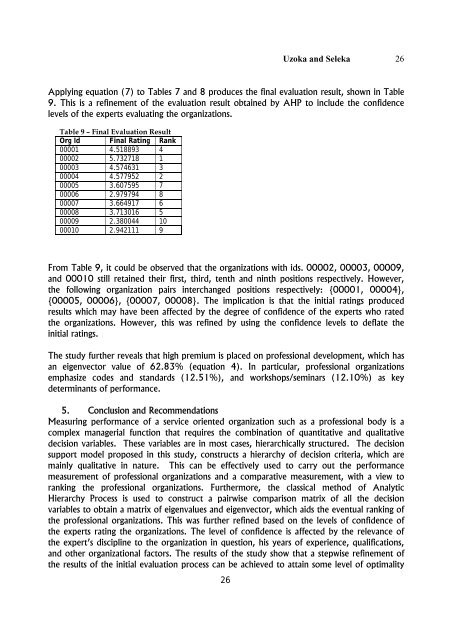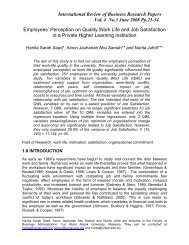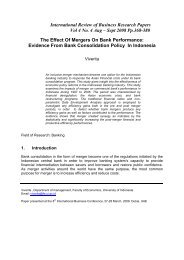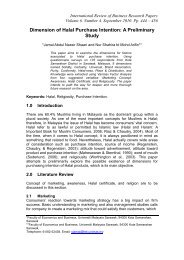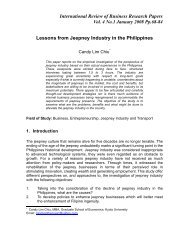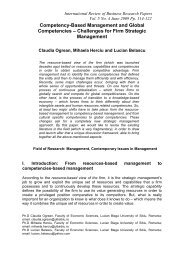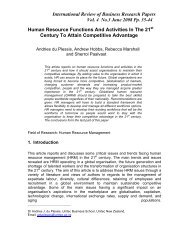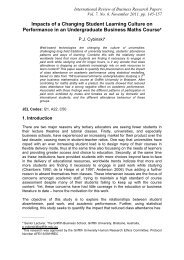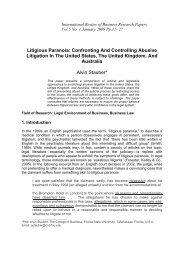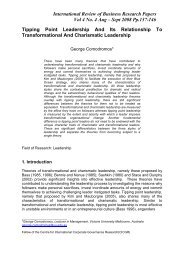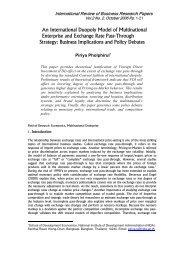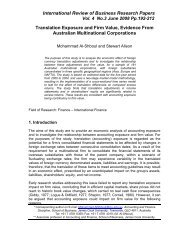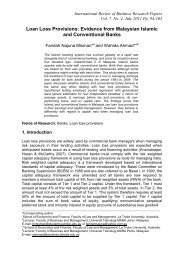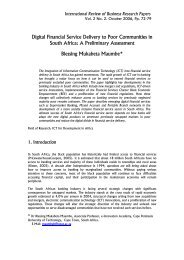A Model for Evaluation of Professional Organizations Using AHP ...
A Model for Evaluation of Professional Organizations Using AHP ...
A Model for Evaluation of Professional Organizations Using AHP ...
Create successful ePaper yourself
Turn your PDF publications into a flip-book with our unique Google optimized e-Paper software.
Uzoka and Seleka 26Applying equation (7) to Tables 7 and 8 produces the final evaluation result, shown in Table9. This is a refinement <strong>of</strong> the evaluation result obtained by <strong>AHP</strong> to include the confidencelevels <strong>of</strong> the experts evaluating the organizations.Table 9 – Final <strong>Evaluation</strong> ResultOrg Id Final Rating Rank00001 4.518893 400002 5.732718 100003 4.574631 300004 4.577952 200005 3.607595 700006 2.979794 800007 3.664917 600008 3.713016 500009 2.380044 1000010 2.942111 9From Table 9, it could be observed that the organizations with ids. 00002, 00003, 00009,and 00010 still retained their first, third, tenth and ninth positions respectively. However,the following organization pairs interchanged positions respectively: {00001, 00004},{00005, 00006}, {00007, 00008}. The implication is that the initial ratings producedresults which may have been affected by the degree <strong>of</strong> confidence <strong>of</strong> the experts who ratedthe organizations. However, this was refined by using the confidence levels to deflate theinitial ratings.The study further reveals that high premium is placed on pr<strong>of</strong>essional development, which hasan eigenvector value <strong>of</strong> 62.83% (equation 4). In particular, pr<strong>of</strong>essional organizationsemphasize codes and standards (12.51%), and workshops/seminars (12.10%) as keydeterminants <strong>of</strong> per<strong>for</strong>mance.5. Conclusion and RecommendationsMeasuring per<strong>for</strong>mance <strong>of</strong> a service oriented organization such as a pr<strong>of</strong>essional body is acomplex managerial function that requires the combination <strong>of</strong> quantitative and qualitativedecision variables. These variables are in most cases, hierarchically structured. The decisionsupport model proposed in this study, constructs a hierarchy <strong>of</strong> decision criteria, which aremainly qualitative in nature. This can be effectively used to carry out the per<strong>for</strong>mancemeasurement <strong>of</strong> pr<strong>of</strong>essional organizations and a comparative measurement, with a view toranking the pr<strong>of</strong>essional organizations. Furthermore, the classical method <strong>of</strong> AnalyticHierarchy Process is used to construct a pairwise comparison matrix <strong>of</strong> all the decisionvariables to obtain a matrix <strong>of</strong> eigenvalues and eigenvector, which aids the eventual ranking <strong>of</strong>the pr<strong>of</strong>essional organizations. This was further refined based on the levels <strong>of</strong> confidence <strong>of</strong>the experts rating the organizations. The level <strong>of</strong> confidence is affected by the relevance <strong>of</strong>the expert’s discipline to the organization in question, his years <strong>of</strong> experience, qualifications,and other organizational factors. The results <strong>of</strong> the study show that a stepwise refinement <strong>of</strong>the results <strong>of</strong> the initial evaluation process can be achieved to attain some level <strong>of</strong> optimality26


